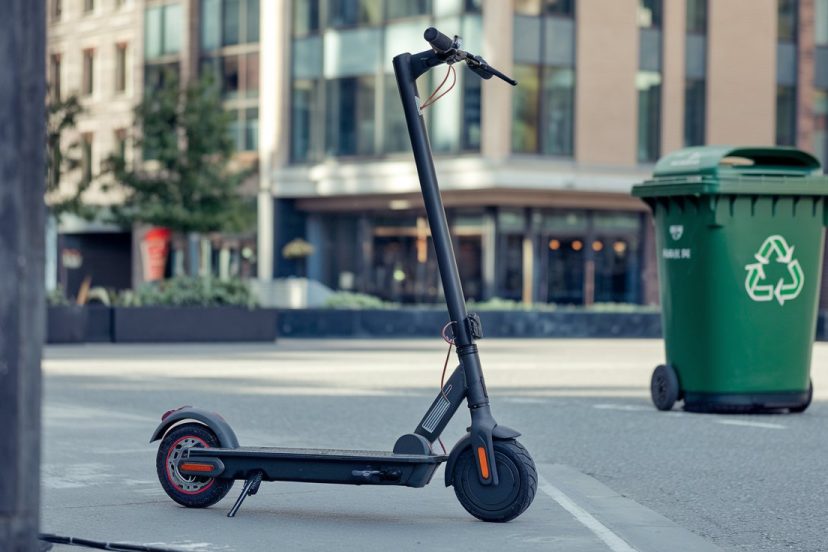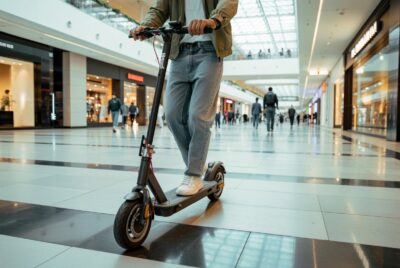Electric Scooter Disposal: What You Need to Know
*We may earn a commission for purchases made using our links. Please see our disclosure to learn more.
As an environmental consultant I have worked with many e-waste recycling programs for over a decade and I have first hand seen how the growing popularity of electric scooters has created new challenges for responsible electric scooter disposal. However if you have a e-scooter that has met its mile or you are just looking to upgrade to a new one it is important that you know the right way to dispose of these devices in order to protect the environment and avoid breaking the law. The increasing use of electric scooters in cities has also led to the problem of electric scooter disposal which is currently a significant issue for both individual users and shared mobility services.
Key Takeaways
- Electric scooters contain hazardous materials like lithium-ion batteries that require special disposal methods
- Many manufacturers and retailers offer take-back programs for proper recycling
- Local e-waste facilities and certain hardware stores accept e-scooters for recycling
- Proper disposal not only protects the environment but may also be legally required in your area
- Some scooter parts can be repurposed or sold for spare components
- Regular maintenance can extend your scooter’s lifespan and delay the need for disposal
- Documentation of proper disposal may be required in certain jurisdictions
Understanding E-Scooter Components
The correct way to recycle an electric scooter starts with identifying the various components of the scooter. We have gained experience in e-waste management over the years and have found that these devices are rather more intricate than they appear, with every element being essential and calling for different action when it reaches the end of its usefulness. Correct electric scooter disposal will help to ensure that valuable materials are recovered, hazardous waste is handled properly, and the impact on the environment is kept to a minimum.
Battery Systems
As the most critical sub-system, lithium-ion batteries power every e-scooter and store and supply energy-dense units. BMS, or Battery Management System, regulates voltage and temperature and avoids hazards like overheating or short circuits, alongside them. Charging circuits are used for energy replenishment, and power distribution components are used to control the flow of electricity to different parts of the scooter.
Electrical Components
Motion relies on a combination of intricate electrical parts. Electric motors convert stored energy into movement, while control boards act as the scooter’s brain, processing input from the rider. Display units present speed, battery life, and settings, offering real-time feedback. Wiring harnesses interconnect all systems, transmitting signals between crucial parts. Sensors and switches detect rider actions, such as acceleration or braking, enhancing functionality.
Structural Elements
Designed for regular use, the frame and body are tough to break. The use of metal increases strength and plastic is used for light weight and cosmetic purposes as well as improved aerodynamics. Handlebars and stems are used for steering and stability, while the deck is made of sturdy materials to support riders.
Mechanical Parts
The smooth operation of an e-scooter depends on various moving components. Braking systems enhance rider safety, using disc, drum, or regenerative methods to control speed. Wheels and bearings determine ride quality, influencing stability and traction. Suspension components absorb shocks, improving comfort on uneven surfaces. Folding mechanisms introduce convenience, enabling compact storage and transport.
External Components
The outermost features influence both performance and rider experience. Rubber tires and grips contribute to traction and handling. Lights and reflectors enhance visibility, increasing safety in low-light conditions. Storage attachments offer space for personal belongings, while additional safety features, such as fenders and protective guards, contribute to rider well-being.
Understanding each of these elements helps determine the best approach for recycling, reusing, or disposing of e-scooters in a way that minimizes environmental impact.
Safe Battery Removal
Handling an electric scooter’s battery requires precision and care, as improper removal can lead to safety hazards such as electrical shorts, leaks, or even fires. Over the years, working with e-waste has provided insight into the common mistakes people make during this process, often leading to preventable incidents. A systematic approach minimizes risks and ensures the battery remains intact for proper recycling or disposal.
Step 1: Review Manufacturer Guidelines
Every scooter model is different; therefore, battery placement, securing mechanisms, and wiring configurations can be different. The owner’s manual is invaluable in providing essential details on safe removal procedures, what tools are required, and what precautions to take. Neglecting this step can lead to unnecessary damage to internal components or problems with reassembly in the event of repairs being necessary. These are all important aspects of knowledge in the context of environmentally friendly electric scooter disposal, to avoid various hazards and to properly handle each component.
Step 2: Prepare Safety Equipment and Tools
Handling lithium-ion batteries requires protective gear to prevent potential hazards such as electrical discharge, chemical exposure, or accidental drops. Essential safety items include:
- Insulated gloves – Prevents electric shocks and enhances grip when handling battery terminals.
- Safety glasses – Shields eyes from sparks, debris, or accidental leaks.
- Anti-static wrist strap – Reduces the risk of static electricity buildup, which can damage sensitive electronic components.
- Proper tools – A set of non-conductive screwdrivers, pliers, and wrenches ensures smooth disassembly without unnecessary force.
Step 3: Power Down and Unplug the Scooter
Before interacting with internal components, confirm the scooter is completely powered down. If the scooter was recently in use, wait a few minutes to allow residual power to dissipate. Unplugging any external chargers or accessories prevents unintended power surges during removal.
Step 4: Document the Battery Setup
Capturing detailed photos of the battery’s connection layout, including wiring orientation, connector placement, and securing mechanisms, assists with future reference. This documentation proves invaluable if reinstalling a new battery or troubleshooting electrical issues later on.
Step 5: Remove Protective Covers and Panels
Many scooters house batteries within an enclosed compartment, often secured by screws or clips. Carefully unscrew and detach these panels without excessive force to avoid damaging adjacent wiring or structural components. If resistance is encountered, double-check for hidden fasteners or adhesive strips securing the cover.
Step 6: Disconnect the Battery
Battery disconnection requires careful attention to prevent accidental sparks or short circuits. Start by identifying the positive and negative terminals, then detach any securing clips, fasteners, or quick-release connectors. For wired connections, disconnect in the order recommended by the manufacturer to avoid voltage imbalances.
Step 7: Inspect for Damage
Before handling the battery further, examine it closely for signs of physical damage, swelling, leakage, or corrosion. A bloated or leaking battery poses significant risks and should never be punctured or disposed of in standard trash. If damage is detected, contact a specialized e-waste facility for safe handling.
Step 8: Secure the Battery in a Storage Container
Once removed, the battery should be stored in a non-metallic, fire-resistant container to prevent accidental electrical discharge. Avoid placing it on flammable surfaces or near heat sources. If immediate disposal isn’t possible, choose a cool, dry storage area away from direct sunlight.
Step 9: Label the Container
Mark the storage container with the battery type, capacity, and date of removal for tracking purposes. Proper labeling ensures compliance with recycling regulations and simplifies the disposal or transportation process.
Following these steps helps maintain safety while preparing the battery for proper recycling or disposal, reducing environmental impact and preventing potential hazards.
Disposal Options
Responsible disposal of an electric scooter extends beyond simple waste removal; it involves choosing a method that aligns with environmental regulations, safety protocols, and long-term sustainability. Years of working in the e-waste industry have highlighted several reliable options for electric scooter disposal, each with distinct advantages in terms of efficiency, accessibility, and environmental impact.
Manufacturer Take-Back Programs
Many major e-scooter manufacturers have implemented take-back programs designed to manage the disposal of their own products. These initiatives are among the most efficient ways to dispose of a scooter responsibly, as manufacturers have direct partnerships with certified recycling facilities and understand how to process their specific components safely. Some notable benefits of these programs include:
- Prepaid shipping labels – Simplifies the return process, eliminating costs and logistical concerns.
- Proper disposal documentation – Ensures compliance with environmental regulations.
- Certified recycling processes – Guarantees that materials are handled using approved sustainability practices.
- Incentives for returns – Some companies offer discounts or store credit toward future purchases.
- Track-and-trace options – Allows monitoring of the recycling process from pickup to final disposal.
Brands like Bird, Lime, and Xiaomi frequently offer such programs, making them an excellent first option when considering scooter disposal.
Certified E-Waste Recyclers
Specialized e-waste recycling facilities process electronic devices, extracting reusable materials while minimizing environmental impact. Choosing a recycler certified by organizations such as e-Stewards or R2 (Responsible Recycling Standard) ensures adherence to best practices for environmental protection and worker safety. These facilities typically offer:
- Component separation – Disassembles the scooter into recyclable and hazardous materials.
- Certified data destruction – Erases any stored personal information in smart scooter systems.
- Material recovery programs – Extracts valuable metals and other reusable elements.
- Regulatory compliance reports – Documents proper disposal for businesses or personal records.
Many certified recyclers provide drop-off locations or scheduled pickups, making this an accessible and eco-friendly disposal option.
Retail Store Programs
Several major retailers now accept e-scooters for recycling through their electronics disposal programs. These stores often collaborate with certified e-waste recyclers, streamlining the process for consumers. Common locations include:
- Best Buy – Accepts various electronic devices, including lithium-ion batteries.
- Home Depot – Offers battery recycling bins and electronic waste drop-offs.
- Local hardware stores – Some independently owned stores participate in e-waste collection programs.
- Electronics specialty shops – Frequently partner with recycling facilities for responsible disposal.
- Automotive parts stores – Certain chains accept batteries and other electrical components for recycling.
Before bringing a scooter to a retailer, confirming accepted materials and any associated fees is recommended.
Local Hazardous Waste Facilities
Municipal hazardous waste facilities provide another reliable option for disposing of e-scooters, particularly when dealing with lithium-ion batteries or other potentially hazardous components. These facilities often offer:
- No-cost or low-cost disposal services – Many communities provide free hazardous waste collection.
- Expert handling – Trained professionals ensure safe and compliant disposal.
- Comprehensive documentation – Proof of proper disposal can be provided upon request.
- Strict environmental standards – Materials are processed in compliance with local, state, and federal regulations.
- Convenient drop-off locations – Some areas have scheduled collection events or designated disposal centers.
Checking local government websites or contacting waste management authorities helps identify nearby facilities and disposal guidelines.
Environmental Impact
Years in environmental conservation have reinforced the urgency of responsible e-scooter disposal. When improperly discarded, these devices contribute to pollution, resource depletion, and ecosystem damage.
Immediate Environmental Concerns
- Chemical leakage from lithium-ion batteries – Harmful substances can seep into soil and groundwater.
- Heavy metal contamination – Lead, nickel, and cadmium from electrical components pose significant health risks.
- Breakdown of plastic components – Microplastics enter ecosystems, affecting wildlife and water sources.
- Toxic emissions from burning electronics – Releases dioxins and other harmful chemicals into the air.
Long-Term Environmental Effects
- Accumulation of non-biodegradable waste – E-scooters contribute to the growing problem of landfill overflow.
- Loss of valuable materials – Rare earth metals, such as cobalt and lithium, are wasted rather than recycled.
- Increased resource extraction – Higher demand for virgin materials accelerates mining activities, leading to deforestation and habitat destruction.
- Greenhouse gas emissions – Inefficient recycling processes release carbon dioxide and other pollutants into the atmosphere.
Wildlife Impact
- Contaminated habitats – Battery leakage pollutes soil and water, endangering local species.
- Physical hazards – Discarded scooter parts can entrap or injure animals.
- Disrupted ecosystems – Toxins alter natural food chains and breeding patterns.
- Bioaccumulation of pollutants – Harmful substances accumulate in organisms, affecting entire food webs.
Legal Considerations
Governments worldwide have implemented strict regulations to govern the disposal of e-waste, and non-compliance can result in fines, legal action, or environmental damage liability.
Federal Regulations (U.S.)
- Environmental Protection Agency (EPA) Guidelines – Establishes proper battery disposal methods.
- Department of Transportation (DOT) Rules – Governs the shipment of hazardous materials.
- Electronic Waste Handling Requirements – Specifies disposal procedures for e-waste.
- Hazardous Material Documentation – Requires tracking of toxic waste movement.
State and Local Laws
- Varying disposal requirements – Some states mandate e-waste recycling by law.
- Local waste ordinances – Municipalities may enforce additional restrictions.
- Mandatory reporting – Businesses must document electronic waste disposal.
- Fines and penalties – Improper disposal can result in significant legal consequences.
Commercial Considerations
- Business disposal obligations – Companies must adhere to stricter environmental policies.
- Record-keeping requirements – Documentation is essential for compliance audits.
- Liability concerns – Improper disposal may lead to legal liability for environmental damage.
- Insurance implications – Non-compliance can affect corporate insurance policies.
Preparation for Disposal
Proper preparation simplifies the electric scooter disposal process while reducing risks and improving efficiency.
Documentation
- Record serial numbers – Helps track ownership and disposal history.
- Take detailed photos – Provides a record of condition before disposal.
- Gather purchase receipts – Useful for warranty or manufacturer return programs.
- Create a condition report – Documents functionality and any existing damage.
- Collect maintenance records – Assists recyclers in assessing component usability.
Physical Preparation
- Remove all personal accessories – Any custom modifications should be detached.
- Clean the scooter – Dirt and debris can interfere with recycling processes.
- Disassemble battery safely – Batteries require separate handling due to hazardous materials.
- Secure loose components – Prevents damage during transport.
- Pack for transport – Use appropriate boxes or protective materials to minimize risk.
Safety Measures
- Discharge the battery to safe levels – Minimizes risks of overheating or combustion.
- Insulate electrical connections – Prevents accidental short circuits.
- Secure sharp edges – Reduces injury risks during handling.
- Label all components – Ensures correct sorting at recycling facilities.
- Use fire-resistant packaging – Lithium-ion batteries should be placed in non-conductive containers.
Proper disposal ensures compliance with environmental laws while protecting ecosystems and valuable resources, reinforcing the importance of responsible e-waste management.
Conclusion
It is important to know how to properly dispose of an electric scooter as it is not only an environmental concern but also an important step in the life cycle of these vehicles that are becoming more and more popular. In my work over the years in e-waste management, I have seen that doing it the right way does make a difference to the environment as well as the effectiveness of recycling valuable materials. It may seem like a lot of effort to find out how to get rid of your e-scooter, but if you think about it, it is not only good for the environment but also helps build a sustainable future for urban mobility.
Frequently Asked Questions
Q: Can I throw my electric scooter in the regular trash?
A: No, electric scooters are hazardous waste and have to be taken to the e-waste recycling center. I have seen a number of cases where the wrong way to dispose of the item had adverse environmental effects and resulted in fines of thousands of dollars in some instances.
Q: How much does it cost to dispose of an electric scooter?
A: Some recycling centers have no charge, while others may request $10-30. Based on my experience, the manufacturer’s take-back programs are usually free, and some of the certified recyclers may demand a small charge for sorting and processing the waste.
Q: Can I sell parts from my old electric scooter?
A: Yes, it is possible to sell if the parts are in relatively good condition. I have seen people manage to sell the motors, displays, and even the frame to repair shops or other buyers. It is important to be very explicit on the condition and the age of the parts that you are selling.
Q: What happens to the scooter after it’s recycled?
A: The scooter is taken apart and then the pieces are separated. Metals are recycled by melting them, batteries are worked on in particular ways and plastics can be recycled. I have worked with recycling facilities and I know that 80% of the materials can be reclaimed and used again.
Q. How do I transport my electric scooter to a recycling facility?
A: If possible, leave the scooter assembled and separate the battery to transport it in a different, safe box. I advise that the scooter should be carried in a vehicle and be in a manner that the scooter does not get damaged. It is always crucial to know the rules that pertain to the transport of lithium-ion batteries when traveling locally.




